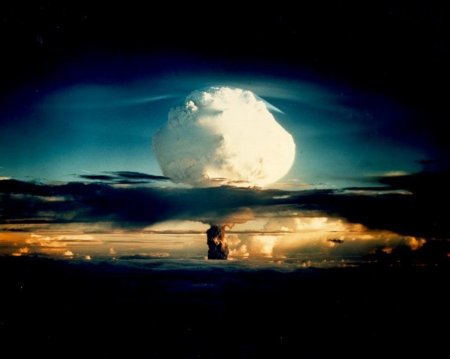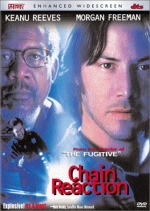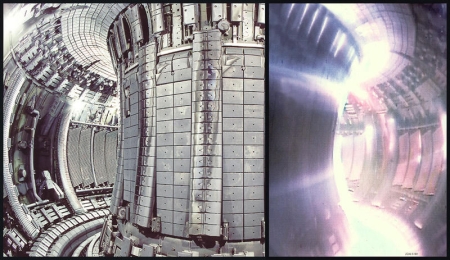Plasma Bubbles Again

We can’t get enough of Plasma bubbles. This times very very hot bubbles though.
If you boil water a part of the energy you put into this boiling goes into the production of bubbles – or in other words into the production of cavities. The process of producing cavities in a fluid is called cavitation. It is possible to produce cavities also e.g. with lasers or ultrasound.
 In 1934 it was observed at the University of Cologne that if cavities are subject to ultrasonic waves then they may emit light. This effect is called Sonoluminescence. Sonoluminescence may or may not occur whenever a sound wave of sufficient intensity induces a cavity to collapse quickly. It is not very well understood why these bubbles emit light, however the fact that they emit light means that there may a lot of energy be concentrated at a ultrasonic- treated bubble. And there are some people who believe that there is even enough energy to get a Plasma which even enables a nuclear fusion (for Plasma see also recent posts about ball lightenings and my comment to it containing this link). Sonoluminescence has been featured in the 1996 film Chain reaction (image also from the wikipedia page). Sonoluminescence must be cool for artistic purposes (e.g. for 3D arts), however I know of no concrete experiments, does someone know?
In 1934 it was observed at the University of Cologne that if cavities are subject to ultrasonic waves then they may emit light. This effect is called Sonoluminescence. Sonoluminescence may or may not occur whenever a sound wave of sufficient intensity induces a cavity to collapse quickly. It is not very well understood why these bubbles emit light, however the fact that they emit light means that there may a lot of energy be concentrated at a ultrasonic- treated bubble. And there are some people who believe that there is even enough energy to get a Plasma which even enables a nuclear fusion (for Plasma see also recent posts about ball lightenings and my comment to it containing this link). Sonoluminescence has been featured in the 1996 film Chain reaction (image also from the wikipedia page). Sonoluminescence must be cool for artistic purposes (e.g. for 3D arts), however I know of no concrete experiments, does someone know?
Nuclear fusion is the “oppposite” of nuclear fission, a process which is used in nuclear power plants.
Nuclear fission means to break heavy atoms into compounds, whereas fusion means to fuse light atoms together. In both processes a lot of energy is released. Nuclear fusion happens in the sun. Unfortunately this energy is also used for nuclear weapons. Fission is used for what is commonly called an atomic bomb, like the one thrown over Hiroshima and Nagasaki and fusion is used in H-bombs (see top image).

However there is a lot of hope in using nuclear fusion also for a peaceful energy production. It is believed that nuclear fusion is less dangerous than the fission in power plants and that there is less nuclear waste produced in the process. There is an interesting european study on the future of nuclear fusion power plants released from the Max-Planck Institute for Plasma physics. However I am not sure wether their projected energy price of 5-10 cents per kilowatt hour includes the waste management!!! (for comparision: solar energy from photovoltaic elements cost as for June 2006 about 18 european cents (~22 US cents)).
The proposals for fusion power plants mentioned the Max-Planck study are of Tokamak type (see image above). However as already said there may be other methods for generating a plasma, which is “hot” enough to enable nuclear fusion. In the nineties there was a big buzz about succesful experiments with cold fusion , but these experiments were sort of turned down by the scientific community. There were recent experiments with almost a similar buzz and fight, which involved experiments using plasma from sonoluminescence. As of last week the buzz was getting even more enigmatic. As a consequence of the disputes the University of Purdue, whose researchers were involved in the quarrels, let an examination committee review the issues. But instead of bringing light into the matter the university declared last week that the issue will be “treated as confidential internal matters.”
Purdue Universitie’s treatment of this issue is no good scientific style. If one publishes a result then it must be possible to verify the result by other scientists, scientific details have to be accessible. Everything else is not science but hocus-pocus.
November 1st, 2011 at 7:28 pm
I’m impressed, I need to say. Actually rarely do I encounter a blog that’s both educative and entertaining, and let me let you know, you may have hit the nail on the head. Your idea is outstanding; the difficulty is one thing that not enough persons are speaking intelligently about. I am very happy that I stumbled throughout this in my search for one thing referring to this. I’ll surely come back and check for updates! Tschau
November 2nd, 2011 at 7:05 pm
@Adele Vergleich
I don’t know which idea you are talking about but thanks anyway for your remark. You use an interesting german dialect at your website.
January 19th, 2018 at 3:41 pm
New Jersey City